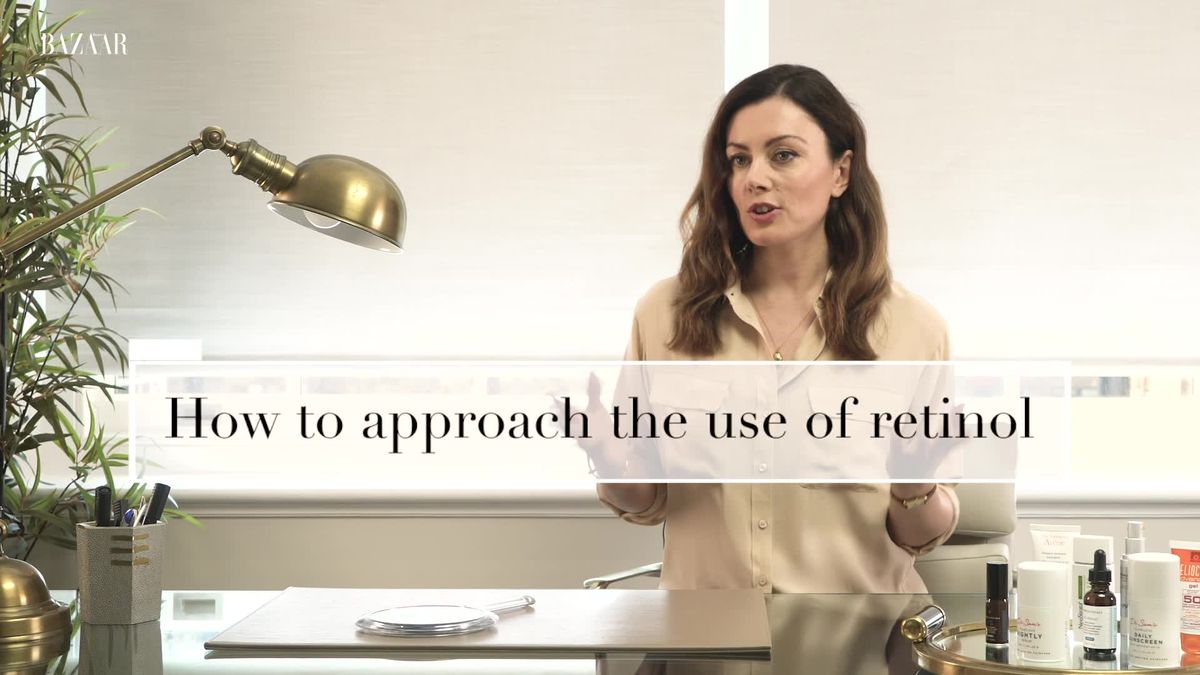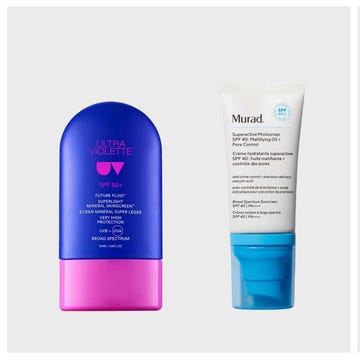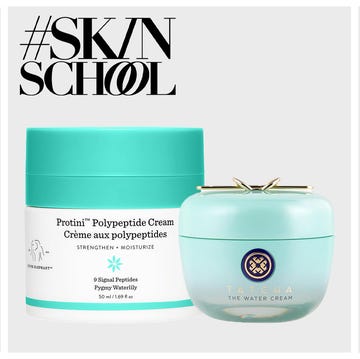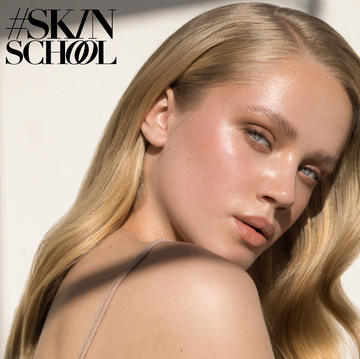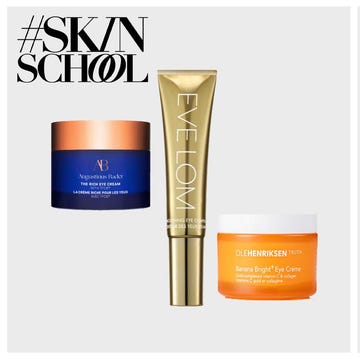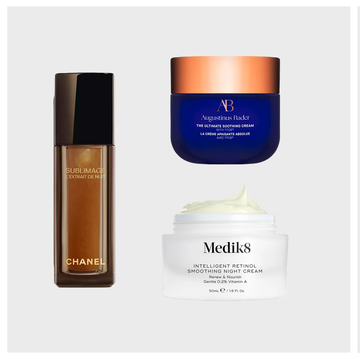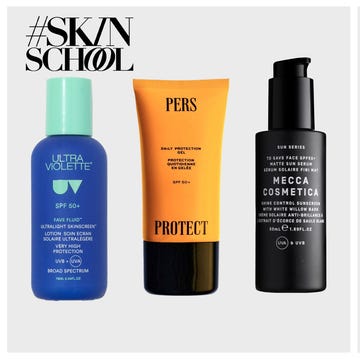Retinol is everywhere. From serums to face creams and even retinol body care, the stellar ingredient has been touted as the gold standard of anti-ageing skincare thanks to its ability to minimise fine lines, plump, and improve the overall appearance of skin. But as with every good thing, its benefits come with caveats.
To walk us through the world of retinol and give us a comprehensive overview of the dos and don'ts of using the ingredient, we spoke to three of the industry's most revered dermatologists and skin experts to get their knowledge on the subject.
Meet the experts
- Sarah Chapman, esteemed international facialist and founder of her namesake clinical skincare brand Sarah Chapman
- Dr Ana Mansouri, aesthetic physician and medical director of Dr Ana The Skin Clinic
- Dr Justine Kluk, dermatologist and acne expert
- Dr Anita Sturnham, a GP specialising in dermatology, and founder of active-led skincare line, Decree
- Dr. Sam Bunting, a doctor and founder of skincare line Dr. Sam's
A comprehensive guide to using retinol
Below, discover everything you've ever needed to know about retinol, from how to introduce the ingredient into your routine to the skincare you should avoid using in conjunction with it.
What is retinol?
Before delving into what retinol does, it's key to understand its origins and its place. Retinol is often used as a catch-all phrase for products formulated with vitamin A, but it's actually a bit more complex than that. Retinol sits in the retinoid family alongside other forms of vitamin A.
"Primary forms of vitamin A in skincare are retinol, retinal, retinoic acid and the ester forms such as retinyl palmitate. The most biologically active form of vitamin A, that can influence the function of a cell, is retinoic acid. All the other forms require modifications and conversions to become retinoic acid," explains Chapman.
We'll unpack the different roles of the retinoid family later in the piece, but for now, let's focus on retinol itself.
"It’s one of the most well-studied ingredients in dermatology and skincare, particularly for uneven skin tone or texture, and signs of ageing," explains Dr Kluk. "Over-the-counter retinol is gentler than prescription-strength retinoids like tretinoin, making it a popular choice for those starting out on a healthy skin ageing routine or with more sensitive skin."
How does retinol work?
One of retinol's more unique qualities is its ability to directly change the way our cells function.
"Retinol works by speeding up skin cell turnover and stimulating collagen production," explains Dr Kluk. "Essentially, it helps your skin shed dead cells more efficiently, smoothing skin texture, making the complexion more even and reducing the appearance of fine lines."
It's this deeper level of interaction with our skin, rather than just a surface-level fix, which makes retinol so effective, and why it's become such a sought-after skincare ingredient.
While retinol products are a resounding recommendation for more mature skin, there is sometimes confusion about the use of retinol to treat acne, which Dr Kluk advises against, and instead recommends seeking a prescription retinoid which will help to regulate and minimise the visible effects of the condition such as painful cystic breakouts.
What are the benefits of retinol?
The benefits of retinol have been well-documented through studies and clinical trials, and while other ingredients can help to tackle individual skin issues, there's no ingredient that's quite as singular in its multi-hyphenate abilities as retinol. Its skincare benefits include:
- Smoothing skin texture and minimising fine lines and wrinkles
- Minimising the appearance of pores
- Fading post-acne hyperpigmentation
- Improving skin firmness by boosting collagen production
Who should be using retinol?
Retinol is one of the most potent skincare ingredients you can buy over the counter, meaning it won't be suitable for everyone and should be approached sensibly. Recently, much has been made about the rise of teenagers using retinol, lured in by tempting TikTok before-and-afters and the brightly packaged products lining the shelves at Sephora (the new teen hang-out location of choice). While retinoids can indeed be remarkably effective for acne, pigmentation and more, it isn't advisable to start using such an active-led ingredient, without professional advice, at such a young age.
"Those with extremely sensitive skin or active skin conditions like eczema or rosacea should seek advice before starting, as retinoids can cause irritation," advises Dr Kluk, while pregnant and breastfeeding individuals should steer clear of using retinol completely.
Most dermatologists will say that you can start including retinol into your skincare from your mid-twenties onwards, but this may not always be necessary. "Retinol can be incorporated when early signs of ageing or other skin concerns are noticeable," says Dr Mansouri.
If you've never used retinol before, start with a low percentage or encapsulated formula, which will steadily deliver the ingredient to your skin over time and lower the likelihood of irritation.
How often can you use retinol?
Your approach to retinol needs to be tailored to your skin type and experience with the ingredient. For example, those with more sensitive skin will want to use it less than someone with 'normal' skin who has used retinol for a year and built up a tolerance, and they may find it especially beneficial to incorporate moisturising ingredients alongside the retinol to buffer any possible irritation.
"I recommend starting with just once or twice per week, applying a pea sized amount at night and avoiding delicate areas including around the eyes, neck and corners of the nose or mouth," says Dr Mansouri. "This can then be slowly increased to every other night over the next few weeks or months as per your own tolerance".
It's a good idea to repeat this approach every time you move up to a higher retinol strength.
How to use retinol
Retinol comes in multiple formats, with the most popular being serums, eye creams and moisturisers.
When using retinol, there are some hard and fast rules that need to be followed to ensure your skin remains healthy and avoids any excess irritation or damage.
- For best results, apply in the evening.
- If using a serum, apply a pea-sized amount onto the skin after cleansing.
- Follow it up with a hydrating and barrier-fortifying moisturiser to help rejuvenate your skin overnight.
- Apply SPF daily. Retinol sensitises skin to the harmful effects of UV rays, and inadequate sun protection will result in hyperpigmentation and skin damage.
There are also certain ingredients you should seek to avoid when using retinol, especially when it comes to actives, which can either cause a reaction or cancel out its effects completely.
"I would be particularly careful with strong exfoliants like AHAs and BHAs," says Chapman. "While both retinoids and acids work wonders for resurfacing, together they can be overly aggressive, leading to irritation, dryness and sensitivity. Think of them as two high-performance actives that need to be introduced thoughtfully – alternate their use rather than layering them."
Dr Kluk also advises applying a vitamin C in the morning if you're applying retinol at night, and notes that benzoyl peroxide can render some retinoids like tretinoin inactive.
When to increase the strength of your retinol?
It can be hard to know when to increase the strength of your retinoid, but climbing the so-called 'retinol ladder' is important if you want to see continued benefits. To determine if you're ready for increased potency, Dr Bunting tells us that, in her clinic, she frequently questions whether patients have reached their goals.
"Given that retinoids can be used to tackle everything from acne to hyperpigmentation and the signs of premature ageing, it’s really helpful to define and track this from the outset (with selfies, ideally)."
"If you’ve been on your chosen starter retinoid for three months and aren’t quite there, then the next thing to consider is whether you’ve achieved skin tolerance. That means a happy skin barrier that permits daily use of your retinoid without irritation or dryness. So, if you haven’t yet reached your goals and your skin is tolerant, it’s time to step up the strength."
Many brands offer products in incremental strengths – including Medik8, Skinceuticals, Paula's Choice, Skin Rocks and Dr. Bunting's own range, Dr Sam's. Her Flawless Nightly Pro 5% Retinoid Serum is more than double the potency of her original Nightly Serum (the first rung in a retinoid ladder, suitable for all), making it ideal for those wanting to up the ante.
When transitioning to a higher strength formula, it’s not uncommon for skin to go through a transition period as you acclimatise. "Prepare for this by applying it every other day initially and try buffering with a layer of moisturiser applied first so that you ease into your more potent product."
This cycle can then repeat until you solve your issue or you reach your skin’s threshold for retinoids. "This can change with the seasons, so remember that what was tough to tolerate in winter might be much easier in spring," Dr Bunting adds.
The retinoid family explained
Sparking waves of confusion, 'retinol' is often used in place of 'retinoid' and has become somewhat of an umbrella term in recent years, used to refer to a whole host of vitamin A derivatives, so it’s not always clear exactly what’s in your serum. “The retinoid family comprises retinol and its natural siblings, such as retinaldehyde and retinyl esters, as well as a large number of synthetic derivatives,” says Dr Sturnham.
Any retinoid must be converted within the skin into retinoic acid before it can regenerate skin cells and stimulate collagen production. Pure retinoic acid can only be found ready and waiting in prescription products such as the oral drug Accutane and topical Treclin cream, which uses the fast-acting synthetic tretinoin.
The retinoids found in non-prescription products must be converted several times before becoming retinoic acid, hence the importance of patience and consistency of use. It's possible to achieve similar results with a non-prescription retinoid, but the time it takes to happen will be considerably longer.
"The gentler versions such as retinyl palmitate and retinol usually come in strengths of 0.2-0.5 per cent as available over the counter," explains Dr Mansouri. "I recommend the SkinCeuticals 0.3 or 0.5 per cent retinol which is an excellent entry level product as the formulation ensures gentle and soothing ingredients that significantly help to reduce side effects."
"We then have higher strength options such as 1 per cent retinol and retinal which are significantly more potent. Prescription retinoids such as tretinoin come in strengths of 0.025 per cent to 0.1 per cent, these are the strongest on the market."
Below, Chapman explains each of the members of the retinoid family and their availability.
Retinyl esters
"Retinyl esters, such as retinyl palmitate, are the mildest of the retinoids since they take three steps to convert to retinoic acid. This helps mitigate issues around irritation and skin sensitivity since the active is gradually delivered."
Retinol
"Retinol takes two steps to convert to retinoic acid. This makes it more potent than retinyl esters, but potentially more irritating to the skin if it’s not introduced slowly or well-formulated."
Retinal
"Since it converts to retinoic acid in only one step, retinal(dehyde) is the strongest form of vitamin A you can get without a prescription. It’s also notoriously unstable. To improve its stability and reduce its potential to irritate the skin, look for advanced forms of encapsulation, such as those in the Sarah Chapman Icon range and Clinic Range Vitamin A serums."
Retinoic Acid
"At the top of the retinoid family is retinoic acid, which you can only access with a prescription. It’s considered to be 20 times stronger than retinol, but it can come with severe side effects, including extreme dryness, irritation and peeling."
Retinol side effects
If you've made it this far, give yourself a pat on the back. You're now armed with the knowledge that you need to start your well-informed retinol journey, but just before you embark, it's important to know the side effects that could come from retinol usage. "How retinoids are delivered into the skin is key to avoiding irritation," explains Chapman. "When applied in their free-form state, retinoids are released too quickly, penetrating multiple layers at once. This rapid diffusion can overwhelm the skin, leading to unwanted side effects."
The most common side effects of retinol, especially for those just starting to use the ingredient, include dry and flaky skin, irritation, sensitivity and a compromised skin barrier.
"Advanced encapsulation and intelligent delivery that safely bypass the skin’s surface are essential for maximising results while preserving the integrity of your skin barrier," she adds.
Looking to invest in retinol? Read Bazaar's detailed guide to the best serum and cream formulas here.

